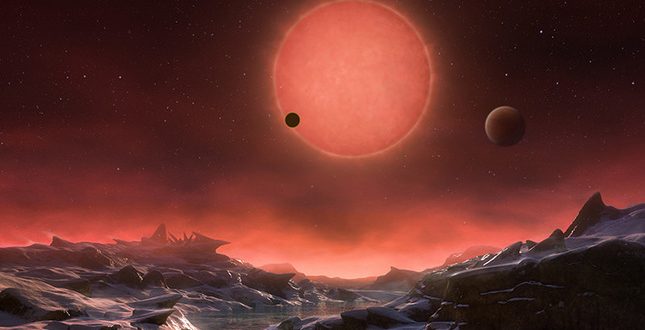Astronomers have discovered not one, not two, but three new Earth-like planets that may be the most promising places yet to look for signs of alien life.
For the first time, an international team of astronomers from MIT, the University of Liège in Belgium, and elsewhere have detected three planets orbiting an ultracool dwarf star, just 40 light years from Earth. The sizes and temperatures of these worlds are comparable to those of Earth and Venus, and are the best targets found so far for the search for life outside the solar system. The results are published today in the journal Nature.
The researchers discovered the planets using TRAPPIST (TRAnsiting Planets and PlanetesImals Small Telescope), a 60-centimeter telescope operated by the University of Liège, based in Chile. TRAPPIST is designed to focus on 60 nearby dwarf stars — very small, cool stars that are so faint they are invisible to optical telescopes. Belgian scientists designed TRAPPIST to monitor dwarf stars at infrared wavelengths and search for planets around them.
The team focused the telescope on the ultracool dwarf star, 2MASS J23062928-0502285, now known as TRAPPIST-1, a Jupiter-sized star that is one-eighth the size of our sun and significantly cooler. Over several months starting in September 2015, the scientists observed the star’s infrared signal fade slightly at regular intervals, suggesting that several objects were passing in front of the star.
With further observations, the team confirmed the objects were indeed planets, with similar sizes to Earth and Venus. The two innermost planets orbit the star in 1.5 and 2.4 days, though they receive only four and two times the amount of radiation, respectively, as the Earth receives from the sun. The third planet may orbit the star in anywhere from four to 73 days, and may receive even less radiation than Earth. Given their size and proximity to their ultracool star, all three planets may have regions with temperatures well below 400 kelvins, within a range that is suitable for sustaining liquid water and life.
Because the system is just 40 light years from Earth, co-author Julien de Wit, a postdoc in the Department of Earth, Atmospheric, and Planetary Sciences, says scientists will soon be able to study the planets’ atmospheric compositions, as well as assess their habitability and whether life actually exists within this planetary system.
“These planets are so close, and their star so small, we can study their atmosphere and composition, and further down the road, which is within our generation, assess if they are actually inhabited,” de Wit says. “All of these things are achievable, and within reach now. This is a jackpot for the field.”
A risk, paid off
For the most part, today’s exoplanetary missions have been focused on finding systems around bright, solar-like stars. These stars emit radiation in the visible band — most often at yellow wavelengths — and can be seen with optical telescopes. However, because these stars are so bright, their light can overpower any signal coming from a planet.
Cold dwarf stars, in contrast, are faint stars that emit radiation in the infrared band. Because they are so faint, these tiny red stars would not drown out a planetary signal, giving scientists a better chance of detecting orbiting planets. However, most missions today are not optimized to observe such stars.
“That means they can’t detect planets around such stars,” de Wit points out. “So you have to design a completely different survey using special instruments and detectors — it’s a risk.”
Lead authors Michael Gillon and Emmanuel Jehin, of the University of Liège, took that risk and built TRAPPIST, the proof-of-concept telescope that looks at 60 small, nearby ultracool stars.
“It’s not looking at 100,000 stars at a time, like the Kepler Space Telescope,” de Wit says. “It’s a few of them that you’re spending time on, one at a time. And one paid off.”
“Worlds shifted in wavelength”
From their observations, the scientists determined that all three planets are likely tidally locked, with permanent day and night sides. The two planets closest to the star may have day sides that are too hot, and night sides too cold, to host any life forms. However, there may be a “sweet spot” on the western side of both planets — a region that still receives daylight, but with relatively cool temperatures — that may be temperate enough to sustain conditions suitable for life. The third planet, furthest from its star, may be entirely within the habitable zone.
As for next steps, de Wit says the objective is clear.
“Now we have to investigate if they’re habitable,” de Wit says. “We will investigate what kind of atmosphere they have, and then will search for biomarkers and signs of life. We have facilities all over the globe and in space that are helping us, working from UV to radio, in all different wavelengths to tell us everything we want to know about this system. So many people will get to play with this [system].”
Agencies/Canadajournal
 Canada Journal – News of the World Articles and videos to bring you the biggest Canadian news stories from across the country every day
Canada Journal – News of the World Articles and videos to bring you the biggest Canadian news stories from across the country every day



